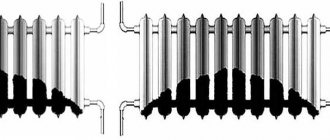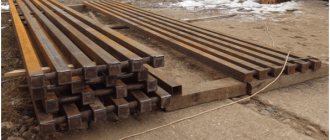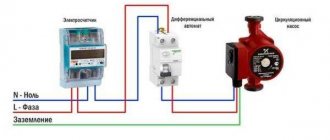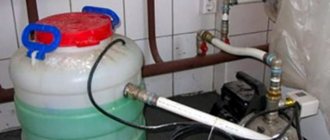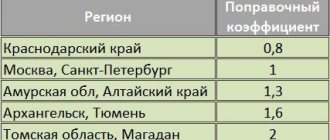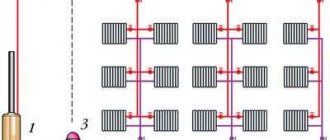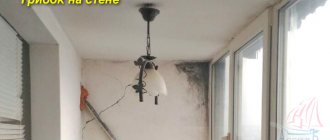Few apartment owners in a high-rise building are completely satisfied with central heating. Uncomfortable temperature, interruptions in the supply of heat and hot water, dampness and fungus in the premises. And most importantly, the high cost of utilities, the quality of which often leaves much to be desired. Do you agree?
There is an effective method of combating the listed negativity - this is individual heating in the apartment. We will talk about options for organizing it and ways to bring the idea to life. The article we presented describes in detail the schemes using various types of fuel, and describes the features of the arrangement.
Gas boiler for heating system
The most common is the autonomous heating scheme, in which the central element is a modern double-circuit gas boiler. It is a fairly compact device that is mounted on the wall. This device has a special chamber in which the fuel combustion process occurs. Moreover, the advantage of this type of boiler is that there is no need to create a special flue. A modern individual heating system in an apartment allows the boiler to use air, which is supplied directly from the street through a small pipe. The boiler is equipped with a specially designed chimney, which allows you to carefully remove smoke without causing inconvenience to apartment residents or their neighbors.
Gas boiler in the apartment
It should be noted that the individual system circuit itself is equipped with a fairly large number of different sensors that monitor its operation at various levels.
The use of such sophisticated technology ensures the fastest and highest quality, and most importantly, safe operation of the system. For example, gas will not enter the combustion chamber until the system receives feedback about normal operation from all sensors present in it. After this, the circulation pump starts working - it is responsible for the continuous movement of the coolant. In parallel with this, a vacuum is created in the chamber using a special fan. And only after that a small spark is supplied, from which the gas flares up. Moreover, the entire verification process takes only a fraction of a second.
Advantages of an individual heating system
Installing individual heating in an apartment is an excellent solution for those who live in multi-storey buildings with a very low-quality centralized heating system. Residents actually quite often complain about interruptions in apartment heating. There are quite a few reasons for such poor-quality operation of the system - outdated equipment, which does not allow for a complete diagnosis of the state of the system, and, as a result, does not make it possible to identify all its shortcomings. In addition, due to regular breakdowns (and to eliminate them), it is necessary to disconnect the entire riser from the heating - and in severe winter this is extremely unpleasant.
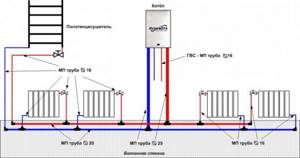
Scheme of individual apartment heating
The advantage of individual heating is that diagnosing the system, as well as repairing it, does not take much time. In addition, you can independently regulate the heating level of the radiators. And even if there is a need to leave for a while, individual heating at home allows you to set the minimum heating level - so your apartment will not be cold. And when you return, you can restore the most comfortable temperature in the room in a matter of minutes.
Requirements for chimney installation
When installing a gas boiler of any type in an apartment in an apartment building, the chimney cannot be made narrower than its outlet pipe. If the device has an open combustion chamber and a power of no more than 30 kW, the cross-section of the chimney pipe cannot be less than 140 millimeters, and with a productivity of 40 kW - 160 millimeters in diameter.
If the boiler has a closed combustion chamber, it is equipped with a coaxial chimney with a cross-sectional size recommended by the manufacturer.
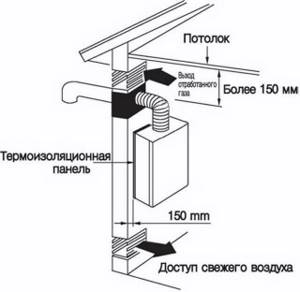
Next you need to adhere to the following rules:
- the pipe going upward from the wall-mounted gas unit must have a length of at least 50 centimeters, and only then can the elbow be installed;
- more than three bends cannot be created along the entire length of the chimneys;
- combustion products from appliances with open combustion chambers are removed into the chimney, and with closed ones, also into the chimney or through the wall directly to the street (the method depends on the project).
What does the user get?
General positive aspects:
- The consumer himself keeps track of and controls the heating level of water and premises. There are no interruptions, warm water all year round, heating can be turned on at any time.
- An apartment heating system allows you to save gas, but at the same time maintain the desired heat level. In addition, it becomes possible to reduce the numbers in payment receipts. And today these indicators are of great importance for every person.
- It is easier to build an apartment building with individual apartment heating, because there is no need to cut into the central pipe, obtain permission and build a new main. If there is a stable gas supply, construction can take place in any, even the most remote, territories. The payback on such a structure occurs quickly. All developers are guided by this, as they manage to save a decent amount.
- Apartment gas heating is an environmentally friendly solution that many people choose. Boilers with a closed combustion chamber are installed in apartments, so there is no need to install additional ventilation. This installation operates independently, since everything necessary is available inside. Combustion products immediately go outside and dissipate, while modern installations are designed to meet all acceptable criteria and safety for the environment.
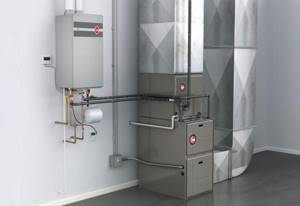
Electrical systems
There are not only many varieties of electric boilers, but also many options that allow you to construct a project. For example, an apartment owner has several options for heating a room:
- warm floor;
- electric boiler;
- Heat pump.
The first two methods are not always advisable to install, since they are expensive to install, and you will also have to pay a lot for electricity. Electricity, like other energy resources, is constantly becoming more expensive. If you install an electric boiler, you must remove all the old equipment and install new ones, just as in the case of a gas installation.
Warm floors are more efficient than a boiler due to its features. If all heating elements are located evenly across the entire floor, and the air is heated from the bottom up, then much less energy will be needed to create comfortable conditions.
But it is better to do autonomous heating of an apartment in an apartment building in the form of a heat pump. Two types of such devices can be used: air-to-air and air-to-water.
People are often interested in the question of whether it is possible to install autonomous heating in an apartment at a low price. In this case, they should not look closely at thermal devices. The cost of heat pump equipment can be high. In addition, the price per unit of energy spent will also be slightly higher when compared with gas equipment.
But on the other hand, if we talk about the long term, then such equipment is interesting to install. Also, a device that operates on the air-to-air principle can perform the functions of an air conditioner in the summer, since their operating principle is the same. In this regard, a heat pump is sometimes called an air conditioner.
Before installing an air type device, you must choose the right model. It is better to install multi-channel equipment in apartments with a large area. Buying such a device for a small apartment is not advisable, since its cost will be significant and the electricity bill will not please you.
For small apartments, it is beneficial to install separate split panels for each room separately. In this case, there will be no need to install air ducts. This option is ideal if the renovation of the apartment has already been completed, since installation does not require breaking down the walls. In addition, one system can produce up to 5 kW of heat. In the northern regions, a combined heating system is used: in winter they use a gas boiler, and in summer - an electric one. Thus, it is possible to save a lot of resources.
Overview of installation of water heated floors in an apartment:
Boiler types
The boiler should be selected only after the necessary calculations have been made.
There are two types of boilers:
- single-circuit (exclusively for heating)
- double-circuit (for heating and hot water supply)

Plus, you need to decide on fuel. This is important because we are talking about saving energy resources. Depending on the type of fuel, boilers are divided into single fuel and combined boilers. Nowadays there are devices on sale that run not only on gas or electricity, but also on liquid fuel.
The lifespan of the boiler is affected by the material from which it is made. Cast iron and steel appliances have the best service life, although many do not like that they are heavy.
Requirements for chimney installation
When installing a gas boiler of any type in an apartment in an apartment building, the chimney cannot be made narrower than its outlet pipe. If the device has an open combustion chamber and a power of no more than 30 kW, the cross-section of the chimney pipe cannot be less than 140 millimeters, and with a productivity of 40 kW - 160 millimeters in diameter.
If the boiler has a closed combustion chamber, it is equipped with a coaxial chimney with a cross-sectional size recommended by the manufacturer.
Next you need to adhere to the following rules:
- the pipe going upward from the wall-mounted gas unit must have a length of at least 50 centimeters, and only then can the elbow be installed;
- more than three bends cannot be created along the entire length of the chimneys;
- combustion products from appliances with open combustion chambers are removed into the chimney, and with closed ones, also into the chimney or through the wall directly to the street (the method depends on the project).
Ban on individual heating in an apartment building
To carry out the reconstruction of a residential premises, the owner of this premises or a person authorized by him directly submits to the approval body at the location of the residential premises being converted: 1) an application for reconstruction in the form approved by the federal executive body authorized by the Government of the Russian Federation; 2) title documents for the residential premises being rebuilt (originals or notarized copies); 3) a project for the reconstruction of the residential premises being rebuilt, prepared and executed in accordance with the established procedure; 4) technical passport of the residential premises being rebuilt; Thus, you need to contact the local government body (district administration) with an application for reconstruction of the apartment, attaching the above documents.
However, it should be borne in mind that in accordance with Art.
Heat supply of an apartment building
The following heat supply methods exist:
- Installation of heat pipelines from central heating networks.
- Installation of an autonomous heating point.
Diagram of a double-circuit heating system.
These heat supply methods are equally effective, but having an individual heat supply point with autonomous heating for several apartment buildings is much more convenient. Since the distance between the heat supply point and the consumer itself is significantly reduced, which means heat losses along the heat transfer line are reduced. This heating method is called decentralized or autonomous.
Autonomous heating and its advantages:
- With autonomous heating of a room, the heat supply source is located at a minimum distance from the house, which reduces the time of heat supply and the percentage of heat losses, which results in further reductions associated with maintenance costs, maintenance and repair of heating networks.
- Since the heat supply point is located nearby, utility costs are noticeably reduced.
- Complete independence from the general city schedule. This means that it is always possible to connect apartment heating if necessary.
- Each apartment owner can set the optimal temperature in the heating system only for his home, while he has the opportunity to independently regulate the level of heat supply.
- There is an excellent opportunity to install a heated floor system.
- The presence of an autonomous heat supply point affects the lower cost of an apartment in a new building.
Autonomous heating and its disadvantages:
House heating scheme using a gas double-circuit boiler.
The best option for autonomous apartment heating is heating powered from a central gas pipeline or through the power supply network, which completely depends on the type of boiler. In apartments, it is most practical to use wall-mounted boilers for heating the home, which, in turn, are divided into gas and electric.
Until recently, there were practically no alternatives to centralized heating in our country. Accordingly, the service was paid at a single rate, despite the degree of use of the service. Today the market is replete with autonomous heating systems of different types and from different manufacturers.
Individual heating
Many homeowners who have financial resources install individual gas heating in their apartments in order to independently control the level of consumption and save on the “heating and hot water supply” column in regularly received receipts, which is growing every year.
The initiative was taken up, and now individual gas heating, even requiring expensive equipment and significant installation costs, is used more and more often. The benefit is obvious: sometimes the money spent can pay off fairly quickly, even within one heating season.
Autonomous heating of the house
Consumers have come to the conclusion that autonomous gas heating at home is very useful and profitable. The autonomous system is closed. Therefore, gas equipment for heating a house is a set consisting of an expansion tank, designed to compensate for the thermal expansion of the coolant, and a circulation pump, which ensures the movement of the working fluid along the heating circuit. Sometimes there is no need for a pump (if the heating system operates on the principle of natural coolant circulation). But today this is rarely practiced.
The advantage of such a gas heating system for a private house is that antifreeze (non-freezing liquid) can be used as a coolant, which makes it possible to do without draining it from the system in case of suspension of work in the winter.
Owners of country houses most often choose individual autonomous systems for heating their premises. In most regions of the Russian Federation, the heating season lasts about nine months, so you need to think about how to heat your house in advance. Every heating system is not perfect - it has its pros and cons. When making a choice, you need to take into account all the nuances: room layout, prices for equipment and installation, etc.
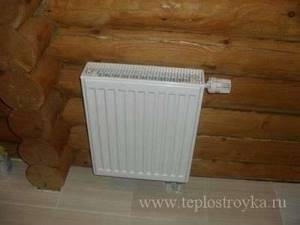
If your house is connected to a gas main, then this immediately tips the balance in favor of gas heating. Individual gas heating will be the best option in this case.
Equipment for autonomous heating of an apartment
Another question that necessarily arises before an apartment owner who decides to switch it to autonomous heating is the choice of boiler based on the power source. Decree of the Government of the Russian Federation No. 307, paragraph 44 of April 16, 2012, which refers to heat supply systems, identifies devices that do not meet established safety requirements. Therefore, the units included in the list of this document are prohibited for installation in apartments located in multi-storey buildings.
Simply put, in this case, only one of two options can be chosen - an electric boiler or a gas-fired one. Which one is better suited for apartment conditions, more economical and safe?
To answer these questions, we can briefly consider their characteristic features.
A gas boiler
Gas boilers are often used for autonomous apartment heating. However, when choosing a unit, you need to know that it must meet certain requirements. These conditions are defined to maintain the safety as well as the efficient functioning of the system.

A gas boiler installed in an apartment must meet a number of requirements
These requirements include the design features of the unit. The boiler must have a sealed (closed) combustion chamber.
Automatic shutdown of the gas supply must be provided in the following cases:
- when the burner flame goes out;
- if a malfunction occurs in the protection circuit;
- during a power outage;
- when the supply gas pressure drops below the limit value:
- when the coolant overheats above the established norm;
- if there are faults in the chimney system.
- The permissible heating temperature of the coolant should be no higher than 95 degrees.
- The coolant pressure in the system should not exceed 1 MPa.
In addition, gas boilers are divided into single- and double-circuit, for example, a double-circuit wall-mounted gas boiler. As mentioned above, the first ones are designed only for heating an apartment, and the second ones are designed for both heating rooms and heating hot water for domestic needs. Naturally, thrifty owners most often prefer the second option.
When submitting an application for disconnection from the heating network, it is necessary to indicate the type of device. This is due to the fact that consent must be obtained from heating networks to disconnect not only from the central heating main, but also from the hot water supply.
Another important factor is the choice of boiler type according to location, since they can be floor-mounted or wall-mounted. Due to the small areas of most city apartments, preference is most often given to wall-mounted options, since boiler equipment is installed in kitchens or on an insulated loggia.
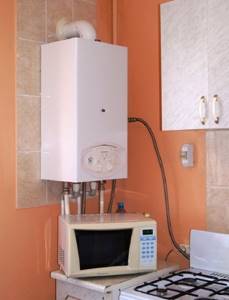
For an apartment, the best option is a wall-mounted double-circuit boiler
Wall-mounted boilers have quite compact dimensions and a neat external design. They are practically no different in appearance from ordinary geysers. The chimney pipe from the gas heating unit is led out into the street through the outer wall of the house, so this particular wall or one adjacent to it is chosen for its placement. The window next to which the boiler is hung often immediately solves the issue of room ventilation.
The wall-mounted boiler has sufficient power to heat a standard-sized apartment.
If funds allow, then preference should be given to a condensing boiler. It is more efficient and economical to operate - it implements additional thermal power extraction due to the condensation of water vapor contained in the combustion products of natural gas. The gain in useful power compared to a conventional boiler with equal consumption of “blue fuel” is 10 percent or more.
Electric heating of the apartment
Unlike gas equipment, the electric heating option is much easier to install, since there are much more places where, for example, the same boiler can be hung on the wall.
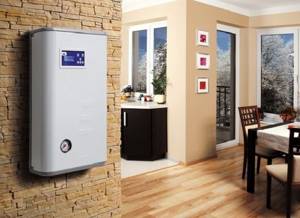
Electric heating equipment is not so cramped in the place of its installation
The main thing that needs to be taken into account when choosing an area for installing equipment is the possibility of connecting a heating circuit to it, as well as supplying a power supply line of the required power. A ventilation system and pipes for removing combustion products are not required.
If you decide to choose an electric heating option, then before starting to implement your plan, you must contact the energy company with a request to check the availability of free energy resources in the house. This organization must give written permission to connect devices of the required power and apply to disconnect the apartment from the central heating and hot water supply. The homeowner must submit this application to the heating network, and a copy of it is attached to the general package of documents.
The list of other documentation for the transition to electric heating will have to be clarified with the energy company, as well as with the self-government organization. Administrative regions of Russia may have their own requirements for the use of electricity for heating.
In any case, to install electric heating equipment, the number of documents that will have to be collected will be much less than when choosing a gas boiler.
Heating an apartment with electricity can be implemented in different ways, which allows you to choose the best option for a particular case:
- Installation of an electric boiler connected to a classic heating circuit with coolant circulating in it.
- Direct heating from separately installed electrical convectors
- Permanently installed or mobile infrared heaters or fan heaters.
- “Heated floor” system using a heating cable or infrared film.
- Several different electrical appliances used in a complex.
You may be interested in information about what characteristics infrared heaters with a thermostat for a summer residence have.
Selection of radiators
The most suitable option for autonomous heating is sectional batteries. The length of the radiator is influenced by the quality of heat transfer of one section, which, in turn, depends on the material of manufacture. One cast iron section, for example, produces 110 watts of heat, steel - 85 watts, aluminum - from 175 to 199 watts, the heat output of one section of bimetallic radiators is 199 watts.
To calculate the area heated by one section with a ceiling height of 2.7 m, you need to divide the heat transfer rate of the section by 100. For example, a section of a cast iron battery heats 1.1 m². Depending on the size of the room, you can calculate the number of sections for the radiator.
Nuances that may be present when calculating the number of sections in a room:
- in a corner room or one with access to a balcony, 2-3 sections are added;
- the decorative panel covering the battery reduces heat transfer by 15%;
- the niche under the window sill in which the radiator is installed reduces heat transfer by 10%;
- windows made of multi-chamber profile, on the contrary, make the room warmer;
- insulated walls and floors maintain room temperature well.
Rules and regulations by law
All nuances are clearly regulated; to familiarize yourself with the information in detail, before starting to implement your plan, you should take a look at Article 26 of the Housing Code.

In this document you will find a list of necessary papers and learn the main aspects regarding the transition to autonomous heating. In 2021, an equally important decree, Federal Law No. 190, was changed, namely, Article 14 covers such points as:
- Conclusion of a contract and the possibility of connecting to the existing infrastructure for the implementation of heat supply.
- Situations are considered in which it is not possible to abandon the central heating center.
- Standards and algorithm of actions for the installation of all communications that are necessary for autonomous heating.
You should also look at decree number 1314 if the equipment will be powered by blue fuel. The document is able to clarify the following:
- Is it possible to connect to the main line of the building in which the apartment is located and how does this happen?
- Details of the procedure.
- Basic requirements for the project and its preparation.
Clause 7.3.7 of SNiP numbered 31-01-2003 provides important nuances that relate to the transition to individual supply. If you carefully study the papers, it becomes clear that such changes can be made in new buildings where such an opportunity was provided.
You can refuse central heating only when installing units with a closed chamber. The design documentation is taken into account, in which you can find information on the following points:
- General information about heating an apartment building.
- Gas supply input diagram, information about the devices.
- Ventilation and house communications, pipes for removing combustion products.
- The area of the room where the boiler is installed should not be less than 15 square meters. m.
It is worth considering the point that it will be possible to completely disconnect the central heating riser from the house with the consent of all residents, without exception. Selective or partial disconnection is prohibited, since the communications will not function properly and the radiators in some apartments will become warm, which is not enough to properly heat the home.
Apartment heating: how it works
Apartment heating is a mini-boiler room in each apartment. Residents have full control over the temperature of the house, can change it, turn the heating on and off at any time.
For apartment heating you need:
- boiler;
- meters that record fuel consumption; heating elements;
- air capture equipment;
- pipes for removing smoke and gases.
The boiler must have clamps:
- flame presence control;
- monitoring of draft, temperature;
- a shut-off valve that operates when there is no fire.
A popular fuel for apartment heating is natural gas. For it, you can choose many options for heating boilers, while heat loss is minimal and output is maximum.
With apartment heating, the entrance, basement and attic are not heated. Due to freezing of these rooms in cold times, the lifespan of the house is reduced.
New buildings usually have apartment heating; in old buildings, if desired, you can also refuse central heating by laying pipes and installing a boiler.

On what basis are they refusing?
Local executive authorities do not always satisfy requests for the conversion of apartments with heating systems. In judicial practice there are reasonable responses to refusals in proceedings in this area.
Citizens are turning to district courts with statements of claim in which they complain about the decisions of the construction and major repairs departments refusing to renovate and remodel apartments.
Residents did not want to be connected to central heating; they considered it more economical to use an autonomous gas boiler.
The reason for the refusal is in the design of the houses; it does not provide for such heat supply. The building diagram shows that it is impossible to disconnect a separate apartment and completely solve the issues of technical support for individual places in the house with general building communications that are developed in the project.
Electric heating indirect heating
In this case we are talking about heat pumps of various types. Electricity will only be used to operate equipment that extracts heat from the environment. Therefore, its consumption is relatively small.
It must be noted that the use of heat pumps is optimal only in areas with a mild climate, where winter temperatures are quite mild and there is no frost.
The heat pump “takes” heat from the environment. The operating principle of such an air-to-air device is shown in the diagram
The best options for heating an apartment are air-to-air or air-to-water pumps. The former are similar in principle to air conditioners, so they can be used in summer to cool air masses indoors.
To obtain heat, you will need to purchase and install expensive equipment, but in the future the heat pump will pay off. A unit of heat obtained in this way costs approximately the same as that obtained using a gas boiler.
Procedure for disconnecting from the centralized heating system
When preparing all the necessary documents for the transition to individual heating of housing, it is necessary to study the relevant legislation:
- Federal Law No. 190 of July 27, 2010;
- Decree of the Government of the Russian Federation No. 307 of April 16, 2012;
- Art. 25, 26 of the Housing Code of the Russian Federation.
The simplest solution would be to install an electric boiler. You just need to make an application and submit it to the district electrical network. If the technical conditions are appropriate, the permit will be issued quickly. But the heat generated in this case may exceed the cost of thermal energy from centralized heating.
Therefore, installing a gas boiler is more profitable in terms of cost savings, since the cost of natural gas is relatively low. But when carrying out individual gas heating, you will have to comply with many formalities:
You must obtain the appropriate technical specifications from the city gas service. Check the chimney for serviceability and obtain a conclusion about this from the All-Russian Voluntary Firefighting Society (VDPO). Obtain the consent of the remaining residents of the house (this point is specified in Part 3 of Article 36 of the Housing Code of the Russian Federation)
This is very important, because if one apartment refuses centralized heating, malfunctions in the operation of the entire system may occur. In addition, it is necessary to obtain relevant documents and find out who owns system elements such as batteries and piping
If they are in common property, it is also necessary to obtain special permission from the neighbors. If the heating components are not common property, permission to disconnect must be obtained from the management company. In city heating networks, obtain the right to dismantle the heating system in your apartment.
For those residents who have gas water heaters installed in their apartments, it will be easier to obtain permission for individual heating, since such buildings have a chimney, and the pressure in the gas pipeline is suitable for the operation of a gas boiler.
Having received preliminary permission for a gas heating project, you should prepare the following documents:
- A statement in which you must indicate that the owner of the apartment plans to make individual heating and disconnect from the centralized system.
- The original registration certificate of the apartment, which should indicate the location of the batteries and pipes.
- Permission from the residents of the house (if the system components are common property) or from the management company.
- Decision on possible redevelopment of the apartment. It is issued by the housing office or management company.
The period for obtaining permission to dismantle the centralized system and install an individual one can last from 3 months to six months. Once permission has been received from representatives of the utility service, you can proceed to dismantling the heating elements in the apartment.
Heat supply of an apartment building
The following heat supply methods exist:
- Installation of heat pipelines from central heating networks.
- Installation of an autonomous heating point.
Diagram of a double-circuit heating system.
These heat supply methods are equally effective, but having an individual heat supply point with autonomous heating for several apartment buildings is much more convenient. Since the distance between the heat supply point and the consumer itself is significantly reduced, which means heat losses along the heat transfer line are reduced. This heating method is called decentralized or autonomous.
Autonomous heating and its advantages:
- With autonomous heating of a room, the heat supply source is located at a minimum distance from the house, which reduces the time of heat supply and the percentage of heat losses, which results in further reductions associated with maintenance costs, maintenance and repair of heating networks.
- Since the heat supply point is located nearby, utility costs are noticeably reduced.
- Complete independence from the general city schedule. This means that it is always possible to connect apartment heating if necessary.
- Each apartment owner can set the optimal temperature in the heating system only for his home, while he has the opportunity to independently regulate the level of heat supply.
- There is an excellent opportunity to install a heated floor system.
- The presence of an autonomous heat supply point affects the lower cost of an apartment in a new building.
Autonomous heating and its disadvantages:
House heating scheme using a gas double-circuit boiler.
- To build an autonomous boiler house, a specific place is required, and often the courtyard of a multi-story building is chosen for this.
- A gas autonomous boiler room requires an additional exhaust gas removal system.
- Since autonomous heating is not yet in such demand, the production of boiler equipment has not yet been established. This means that the cost of a decentralized heating system and domestic hot water remains high.
The best option for autonomous apartment heating is heating powered from a central gas pipeline or through the power supply network, which completely depends on the type of boiler. In apartments, it is most practical to use wall-mounted boilers for heating the home, which, in turn, are divided into gas and electric.
Peculiarities
Apartment heating is gaining momentum in Russia, so today we can say exactly what the advantages and disadvantages are. Generally speaking, there are more pros than cons. To understand this issue, in 2000, the Russian State Construction Committee conducted some research in which autonomous heating was used in the construction of apartment buildings.

Today there are such houses in Smolensk and St. Petersburg. Wall-mounted boilers began to be actively used in other cities, because it was profitable. Even with a commercial building, this was taken as a basis. Because people understood that in this way it was easier to create the desired microclimate in the house and not overpay. After all, everyone has their own settings for recording heat consumption.
As a result, such experiments brought a lot of positive results, and living in apartments became more comfortable. After this, documentation appeared on the basis of which it was possible to build such houses. Nowadays, autonomous heating is at the peak of popularity. In addition, the regions appeared their own regulatory documents, according to which the apartment heating system was completely legalized.
As a result, the number of houses with such heat supply increases every year. This happens in different regions and cities. From this it is clear that efficiency is present at every stage. It is in this way that problems of the housing and communal system can be solved. At the same time, today they are even reconstructing old buildings.
Brief instructions for installing a geyser
This information should not be considered as a guide to action. Replacing a water dispenser with your own hands, as well as working with any gas appliances, is prohibited not only by law, but also by common sense: such “amateur activity” in an apartment building can lead to disastrous consequences.
For work use:
- certified geyser;
- PVC water pipe;
- American type fittings;
- pipe cutters;
- soldering iron;
- metal-plastic pipe for gas supply;
- fittings for metal-plastic;
- gas taps;
- salt and magnetic filter;
- Mayevsky crane;
- regular water tap;
- proportional wrenches;
- drill;
- as well as dowels and screws.
Progress of work and basic requirements for them:
The choice of installation location for the dispenser should be based on the possibility of arranging the hood in accordance with all rules and regulations, the convenience of the dispenser location, as well as the possibility of supplying communications.
The volume of the room in which the column will be installed must be 8 m³ or more.
Speakers are installed only on fireproof walls. In another case, the fire-resistant surface is lined with a galvanized sheet from 0.8 to 1 mm thick, having previously secured a sheet of basalt heat-insulating cardboard from 3 to 5 mm thick to the wall.
IMPORTANT! Installing speakers on wooden walls is prohibited!
The column is hung on the wall, taking into account that the installation height can be arbitrary, but do not contradict the rules for installing the air vent. There should be at least 15 cm from the side panel of the speaker to the wall, and a space of at least 60 cm should be left in front of the front panel of the speaker.
At the installation location of the column, mark the fastening points, then drill them with a drill. The column is secured with self-tapping screws.
The standards for installing the connection between the column and the water supply system provide for the use of metal pipes or flexible hoses with an internal diameter of at least 13 mm. In this case, the length of the hose or pipe must be no more than 2.5 m (similar parameters must be observed when arranging a connection to the gas supply system).
Installation of a gas connection to a column must be carried out only with a shut-off valve installed.
Before installing the chimney, check the draft. Under normal conditions, it should be approximately 1.96-29.40 Pa (depending on the type of room).
The gas exhaust pipe must have at least 110 mm in diameter, while its length cannot exceed 2 m, but cannot be less than 300 mm. The slope of the gas exhaust pipe must be at least 2° upward.
IMPORTANT! It is also prohibited to independently carry out the first release of water through the column. All work related to testing the system, installing a new column or dismantling an old one must be carried out only by qualified representatives of GORGAZ. The speaker installation diagram must be included with the product.
The manufacturer's advice on installing this device is also given there.
The speaker installation diagram must be included with the product. The manufacturer's advice on installing this device is also given there.
Only kitchens and non-residential premises intended to accommodate these heating devices are suitable for installing speakers.
However, the installation rules prohibit installing a column in the bathroom, because... this room does not meet the basic requirements (see SNiP 2.04.08-87 GAS SUPPLY).
In previous regulations, the installation of speakers in bathrooms was allowed. But after the change in legislation, we can only talk about moving the speaker from the bathroom to the kitchen or any other non-residential premises, if it is necessary to replace the device with a new one.
Figure 4 — Gas water heater installation diagram
The requirements for installing speakers also make it possible to consider each individual case: for example, in a private house that does not belong to typical buildings, it may be possible to install a speaker in a wide corridor or a room without windows, but having access, however, to a spacious room with a window.
Figure 5 — Checking draft before installing a gas water heater
Classification of central heating systems
The variety of central heating organization schemes that exist today makes it possible to rank them according to certain classification criteria.
By thermal energy consumption mode
- seasonal. provision of heat is required only during the cold season;
- year-round. requiring constant heat supply.
By type of coolant used
- water - this is the most common heating option used to heat an apartment building; such systems are easy to operate, allow you to transport coolant over long distances without deteriorating quality indicators and regulate the temperature at a centralized level, and are also characterized by good sanitary and hygienic qualities.
- air - these systems allow not only heating, but also ventilation of buildings; however, due to the high cost, such a scheme is not widely used;
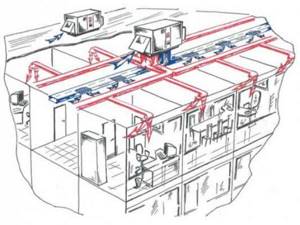
Figure 2 – Air circuit for heating and ventilation of buildings
steam - considered the most economical, because small-diameter pipes are used to heat the house, and the hydrostatic pressure in the system is low, which makes it easier to operate. But such a heat supply scheme is recommended for those objects that, in addition to heat, also require water vapor (mainly industrial enterprises).
According to the method of connecting the heating system to the heat supply
independent. in which the coolant (water or steam) circulating through the heating networks heats the coolant (water) supplied to the heating system in the heat exchanger;

Figure 3 – Independent central heating system
dependent. in which the coolant heated in the heat generator is supplied directly to heat consumers via networks (see Figure 1).
According to the method of connection to the hot water supply system
open. hot water is taken directly from the heating network;

Figure 4 – Open heating system
closed. in such systems, water is drawn from a public water supply, and its heating is carried out in the central network heat exchanger.
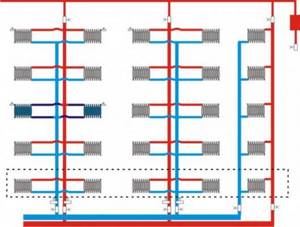
Figure 5 – Closed central heating system
If a gas water heater is not provided
In a house where the installation of gas equipment, such as a stove, is permitted, the installation of a water heater may be prohibited. This restriction applies to houses with more than 11 floors. No regulatory authority will issue permission to install a water heater in such an apartment, as this is dangerous for the residents.
In addition to the number of floors, redevelopment may be a reason for refusal. Studio apartments are not suitable for installing gas equipment, since the devices must be installed in non-residential premises.
If the kitchen is combined with a living room, this makes the use of gas appliances illegal. These limitations must be taken into account before redevelopment. The same can be applied to apartments where there is no kitchen or is shared.
Image gallery Photos from Gas water heaters with a flow-through principle of operation in apartments are mainly used to prepare hot water; in old two-story buildings they can serve as a unit for maintaining the temperature of the coolant. Installation of a gas water heater is allowed in houses no higher than five floors that are not connected to a centralized hot water system. In high-rise buildings connected to a central hot water supply system, gas equipment is not installed. Small private houses with an area of no more than 150 m² are also equipped with gas flow heaters. The instantaneous water heater processes the water passing through it in the amount necessary for immediate use. The gas water heater is not intended to form a supply of hot water. and maintaining its temperature, which explains its small, easy-to-use dimensions. Gas instantaneous water heaters for apartments are available in wall-mounted versions. They should be located so that free access is guaranteed for servicing the water heater and its connection points. Installation of more than two gas water heaters in one room is not allowed. The use of both flow and storage equipment is allowed in quantities of 1 piece each. An exception is multi-level apartments. Gas heating equipment is allowed to be installed only in private apartments and houses; placement in dormitories, gyms, hotels, etc. is prohibited. where different people can be used Flow-through gas water heater Productive small-sized device Operation of a water heater in private homes Advantages of a gas water heater Compact dimensions of flow-through equipment Features of heater placement Two gas water heaters in one room Installation of the heater only in residential buildings and apartments
If the house does not fall under these restrictions, then it is necessary to collect a package of documents to register the device.
The procedure is as follows:
- Write an application to the gas distribution company.
- Get a plan from the BTI or Rosreestr.
- Provide an extract from Rosreestr confirming ownership.
- Contact a specialized organization to draw up a project.
- Find certified specialists from an organization that has access to gas work.
After this, specialists will make an insert into the gas pipe, connect the device and put the water heater into operation.
It is highly not recommended to install a geyser yourself, bypassing the legal order. These actions not only lead to fines, but also put people's lives at risk.
How to switch to gas heating
The constant struggle with the problems described above forces you to take the first step towards installing an autonomous system. It makes sense to think in advance about how to install gas heating in your apartment in order to calculate the cost of purchasing equipment and get an idea of the upcoming work.
First, document that there are real problems. To do this, you need to submit the appropriate applications to your heat supplier and the sanitary and epidemiological station.
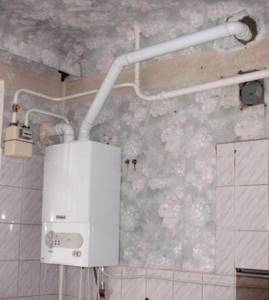
In most cases, heat supply organizations are against autonomous heating. Some houses were designed directly for centralized heating. Disconnecting residents from the system leads to system imbalance
These preliminary actions will help to challenge in court a possible refusal to install individual heating. Issues of this nature are often resolved in court.
To facilitate the process and gain confidence that you are right, you need to familiarize yourself with several regulatory documents.
For residents of the Russian Federation, this list includes:
- Federal Law 190-FZ “On Heat Supply” dated July 30, 2010;
- Decree of the Government of the Russian Federation No. 307, explaining the rules and features of the provision of utility services to residents;
- Articles 25 and 26 of the Housing Code of the Russian Federation: explaining the features of the reconstruction and redevelopment of premises in apartment buildings and the grounds for their implementation.
Judicial practice shows that there are many precedents for successfully challenging unfounded refusals.
Refusal from central heating supply
The text of Federal Law No. 190 specifies a list of individual heating sources that are allowed for installation in apartment buildings, as well as a list of devices prohibited for various reasons. The law, therefore, does not prohibit the use of modern gas boilers that meet the requirements.

To disconnect from the central system, you must prepare a lot of documents. Some owners are shocked by the time and amount required to implement their idea. Even though the fight will be difficult, autonomy is worth fighting for
According to Article 26 of the Housing Code of the Russian Federation, it is necessary to collect a whole package of documents to carry out the reconstruction of residential premises. This includes:
- A properly completed application for the need for reconstruction from the owner or responsible person;
- Original technical passport for the apartment;
- Copies and originals of notarized documents establishing the right to own and dispose of housing;
- The original of the developed project for the reconstruction of a residential apartment;
- Written consent of all family members and other residents registered in the premises;
- Conclusion of the authorities involved in the protection of architectural monuments on the admissibility of reconstructing the premises.
The structure providing central heating services has been considering the application for some time. It issues a letter with permission to disconnect the apartment from the central system. This document will be required when ordering technical specifications for the installation of individual gas heating within an apartment building.
The application for ordering technical specifications is submitted to the gas industry. The answer is usually given within ten days. A refusal can be obtained in cases where there is no gas in the region, it is impossible to purchase it in cylinders or regularly replenish the supply of blue fuel in the gas holder.
After formalizing the refusal of utility services in the field of heat supply, old and inefficient systems should be dismantled. To do this, you need to have a project to disconnect from central heating.
The basis for drawing up the project is a letter from the Homeowners Association with permission to terminate the use of the services of the heat supply organization. Be sure to receive a written response and save it. If you refuse this letter, you can go to court to appeal.
Having received the project documentation in your hands, you need to go with it to the regional branch of the All-Russian Voluntary Firefighting Society. After all checks, they issue a fire safety certificate for the project. If the need arises, a design for the chimney is also made there.
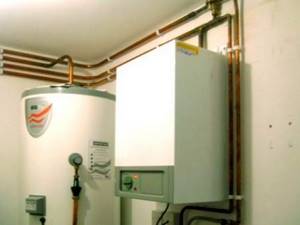
Sometimes the city administration delays the approval procedure. In this case, it is necessary to write an application addressed to the head of the administration to speed up the process. If after this you have not made progress, then consider going to court.
All documentation must be approved by the city administration. The conclusion on approval or refusal is accepted within forty-five calendar days from the date of its submission.
A refusal to renovate an apartment in an apartment building is issued on the basis of Article 27 of the Housing Code of the Russian Federation if the owner has not provided all the required documents. An unjustified refusal can be appealed in court.
Preparation of documentation and obtaining approval for the refusal of central heating supply. This is an initial preparatory step towards the legal transition to an individual gas heating system.
The list of required documents differs depending on the region and the specifics of the law. Comprehensive information can be obtained by consulting your city administration.
Permission to install a gas boiler
To successfully install a gas boiler, a number of formalities must be observed. First of all, you need to submit an application for the need to install an individual gas system in the city gas supply.
At the same time, you need to obtain a document confirming the serviceability of the ventilation and chimney. It is requested from the fire department.
Each neighbor must give their written consent to your desire to install an autonomous system. This measure is necessary due to the fact that when one or more apartments are disconnected from central heating, some malfunctions in the operation of the heating system may occur for the remaining residents of the house.
So, some apartments may begin to receive more heat, while others, on the contrary, less.

Installing a gas boiler without approval, technical specifications and design can lead to equipment damage, physical injury and litigation. Treat all gas appliances in your home responsibly
This problem is due to the fact that most heating systems in apartment buildings are outdated many years ago and require constant maintenance.
Next, you should recognize the manager by pipes and batteries. If they are managed by a household, then it is necessary to obtain permission for dismantling from neighbors. If they are subordinate to a government organization, then you need to write a statement to this company with a request to disable the systems.
After receiving all the documents and permits, you must contact the city heating network and get permission to draw up and approve a scheme for the future autonomous heating.
When the entire list of documents has been received and all previous stages have been completed, you can proceed directly to the dismantling of old communications. Typically, collecting the required papers takes from three to six months. Before submitting a technical certificate for the boiler to the gas organization, you should select the equipment model that is suitable for your apartment.
Boilers are single-circuit and double-circuit. Double-circuit gas units provide residents not only with heating, but also with an uninterrupted supply of hot water. This allows you to save gas and reduce service costs. Modern oversized devices have closed combustion chambers.
This design simplifies installation and eliminates the need for a gas duct. A special fan drives air from the street and then releases combustion products back through pipes installed for this purpose.

The design of gas boilers is light in weight and size. The boiler is installed on mounting strips on a load-bearing wall if all requirements for the room are met. Usually the boiler is connected to the gas main using metal pipes
The advantages of gas boilers include a multi-level security system, which includes an automatic system shutdown function. A number of sensors monitor the draft force and the presence or absence of flame.
A safety valve monitors the fluid pressure in the system and, if the norm is exceeded, is responsible for draining the excess fluid. The expansion tank allows you to control the expansion of the liquid when heated. The air vent is responsible for removing excess air from the system.
Sample list of documents
Since installing your own heating system refers to the refurbishment of a residential premises, the list will include:
- an application drawn up in a special form;
- documents establishing the right to own housing: state registration certificate, deed of transfer of ownership, gift agreement, document confirming the right of inheritance (originals or copies certified by a notary);
- certified copies for each owner and a statement signed by all owners (if the apartment is in shared ownership);
- a copy of the technical passport of the premises;
- consent of family members of the tenant and residents of the apartment building, documented in the form of minutes of the meeting of apartment owners (if the area is municipal);
- conclusion of the body responsible for the protection of architectural monuments, historical or cultural heritage on the possibility of redevelopment (if the house is an architectural, cultural or historical value).

The most difficult thing will be to prepare and provide technical documentation. These include:
- redevelopment project for the installation of a gas boiler, including gasification of the premises and changes to the central heating system;
- a copy of the passport for the electric boiler, technical conditions, agreement confirming the permission of the maximum power, which exceeds the capabilities of the boiler (when choosing an electric heating device);
- Specifications for disconnecting the wiring in the apartment from the communal heating system;
- Specifications for ventilation;
- Specifications for supplying gas networks.

Design and installation of an autonomous system
At this stage, the apartment owner, together with the designer, carry out the necessary calculations and decide what kind of individual heating system will be in the room. Depending on this, a gas boiler suitable in terms of power and characteristics is selected.
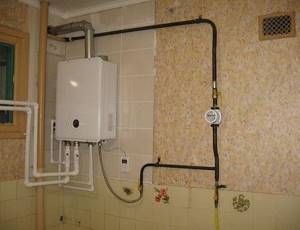
After installing a wall-mounted gas boiler, you should connect the coolant heating circuit to the installed heating system. The operation of the boiler is controlled by automation and a thermostat connected to it; the circulation pump built into the column is responsible for the movement of the coolant.
According to the rules, the required power is 100 W per square meter of area. This value is quite enough even for corner apartments, connected by many common walls with neighbors, which guarantees no heat loss.
The wiring, that is, the diagram according to which all heating devices and connecting pipes are located, depends on the type of boiler chosen and the principle of coolant movement: natural or forced. The layout is chosen at the design stage. It can be single-pipe or double-pipe, horizontal or vertical, top or bottom.
In addition to the diagram of the new autonomous system, the content of the project should include a section containing data on the dismantling of the old heating system. It specifies the details of disassembling and removing batteries and connections. It should be taken into account that the risers running through the apartment cannot be dismantled and must be insulated.
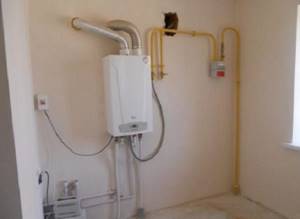
Before initiating a refusal from central heating and hot water supply, compare all the pros and cons of an individual system. Only after making the calculations, start collecting all the necessary documents
The individual heating scheme of your apartment must correspond to the possibility of installing radiators with thermostatic valves at the inlet. Conventional aluminum structures are suitable for this purpose.
If desired, the owner of an apartment on the ground floor has the opportunity to design a system of water heated floors simultaneously with autonomous heating. For owners of apartments located above, this option is not available, since the floors are not designed to support the weight of the system with coolant and concrete screed.
If the construction of a water floor heating system is approved, even on the first floor, separate procedures are envisaged to strengthen the lower floor by installing additional supports in the basement.
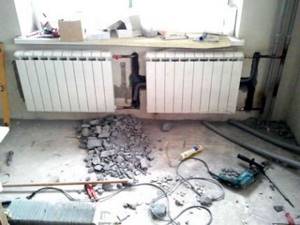
Perhaps after design it turns out that it is necessary to install new radiators. Despite the high cost of modern radiators, their quality plays an important role in the transfer of heat into the room. Therefore, it is better to choose high-quality models
If your home experiences periodic power outages, then you should consider purchasing an uninterruptible power supply. Thanks to the BPS, your gas boiler will work without interruption and continuously provide your apartment with heating and hot water.
Benefits of Autonomous Systems
An autonomous home heating system appeared for the first time in Europe. However, having a significant number of advantages, it quickly spread throughout the world. Today, in most countries, residents prefer to use individual systems for heating their apartments. And for good reason, since this method has several advantages over a centralized system:
affordable price. It is this advantage of the system that often becomes decisive when abandoning a centralized system. The fact is that even though you have to pay for the amount of gas used for heating, you will pay significantly less for utilities. In addition, unlike a centralized system, you can use autonomous heating when it is needed. That is, if necessary, you can adjust the heating intensity, and if you leave, you can simply turn it off completely for a while. This saves a lot of money. In addition, you will not experience the inconvenience that occurs when one of the heating elements of the riser of a centralized system breaks down - after all, in this case, several apartments are left without heating at once.
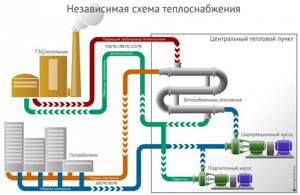
Heat supply diagram for a multi-storey building
- saving natural resources. With the gradual abandonment of centralized heating, users are thereby significantly helping to save a huge amount of resources that previously had to be spent on heating the house. In addition, with individual heating, it becomes possible to independently adjust the heating level. But even in this case, the heating boiler is often turned off by the user - that is, additional savings in natural gas occur.
- improving the quality of heating. In fact, those who have switched from a centralized heating system to autonomous heating in an apartment building have noticed a significant improvement in heating levels. Quite often this is due to the fact that heat is constantly leaking in a centralized system. In addition, autonomous heating of a residential building located in one apartment requires significantly less money and time for prevention.
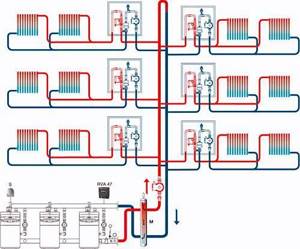
Schematic diagram of heating of a high-rise building
Another advantage of autonomous heating is that the system also allows you to constantly heat water. That is, there is simply no need to use such resource-intensive boilers.
Reasons for the spread of the system
Today, individual heating is becoming increasingly popular. And there are several good reasons for this.
Comfort and accessibility. Why do many people strive to install autonomous heating systems? The answer is simple - they are not satisfied with the quality of the centralized heating system at home. Frequent breakdowns, low pressure in the pipes (and as a result - cold batteries), high cost of the service - all this causes extremely negative reviews. While individual heating in an apartment can create ideal amenities. First of all, you yourself can control the heating level of the radiators and the operating time of the heating boiler. In addition, even adding up the price of the boiler and components, the cost of installation and fuel will be significantly less than what is spent on regularly paying the heating bill provided by the utility service.
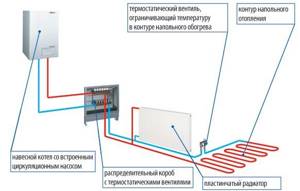
Autonomous heating in the apartment
Another significant advantage of individual heating in an apartment building is that the so-called “warm floor” and heated towel rail can be connected to the system. In addition, it is also used to heat water. That is, by installing a modern heating system, you can save on electricity bills - because you no longer need a boiler.
How to make a calculation
A comfortable temperature in the apartment will be maintained if the heating system is installed correctly. To do this, it is necessary to accurately make all calculations, which will depend on the area of the room (S) and the boiler power (W) per 10 m². It is also necessary to take into account the climatic features of the region. For example, for the Moscow region the power density ranges from one to one and a half kW; in the northern regions - from one and a half to two kW; in the southern regions - from 0.7 to one kW.
Heating calculations also depend on the design and type of heating system. The best option for an apartment is a two-pipe system. It is more complex and more expensive than a single-pipe system, but the heating quality will be higher. All batteries, from the first to the last, will heat up evenly. The single-pipe system is only suitable for a small number of radiators.
Advantages and disadvantages of individual apartment heating
There are quite a lot of positive aspects; owners can afford to turn on the equipment themselves in the off-season, and do not have to wait for the start of the heating season in the fall. When connected to central heating communications, it is impossible to adjust the temperature as accurately as possible; this can only be done using a separate unit.
In the age of modern technology, autonomous heating can be controlled remotely using a tablet or smartphone; for this you just need to install an additional device.
Consumption will decrease significantly, which will be noticeable literally in the first year of using a gas or electric appliance. Some models are capable of organizing a continuous supply of water not only to the heating circuit, but also to the hot water taps; this type of product is known to everyone as a double-circuit boiler.

There are also disadvantages, these nuances should be paid attention to even at the stage of thinking about the question of whether it is worth doing individual heating; the disadvantages of the procedure include:
- Difficulties in paperwork.
- Compliance with all rules that were provided by law.
- Organizing an appropriate ventilation system, which will lead to additional waste of the budget.
- Installation belongs to the category of work of increased complexity; the payment for specialists will be high.
- Safety issues and all responsibility when operating the unit falls on the owner of the apartment.
Some costs will soon pay off, because such organization of the system is much more economical than central heating. DHW leaves much to be desired, because in most buildings the heated water is turned off at 22:30, which is not entirely convenient, but with an autonomous supply such situations can be avoided.
Installation of an autonomous heating system in an apartment step by step
Coordination of all planned alterations with the relevant organizations. Notifying neighbors that work is planned at a certain time. The time frame will need to be agreed upon in advance, since such repair work is always accompanied by loud noise. You don't want conflicts with your neighbors. If gas heating is planned, then a special chimney must be equipped in advance. If the device is electric, you will have to install a separate line of appropriate power in advance to power it. Where the heating device is installed, the floor finishing must be made of non-combustible material. According to the standards, a certain distance from walls and furnishings is provided. The next step will be to mark the boiler, pipes and radiators according to the prepared project. If the system operates with a gas boiler, you will need to install a gas flow meter. This is not required for electrical equipment. Buy and deliver the boiler to the installation site. While still in the store, check it for completeness, as well as for the absence of visible defects and damage. Even minor scratches on the body may indicate that the boiler was either transported incorrectly or was dropped by movers. And all this can lead to breakdowns that are not noticeable upon purchase and can only be discovered during operation. Installation of gas equipment
Particular attention should be paid to leveling the boiler horizontally and vertically; Only correct installation guarantees stable operation of such a heating device. Laying heating pipes according to the project diagram. As a rule, circuits with forced coolant circulation are used
Therefore, if a pump is not provided inside the gas boiler, then it will need to be purchased and installed. Boiler piping - connecting equipment to water supply and gas supply pipes. And also an exit to the chimney. Connecting heating radiators. If necessary, purchase and installation of new heating elements. Test launch of an autonomous heating system. It is necessary in order to find and eliminate possible leaks in joints, and check the performance of gas or electrical equipment, as well as the efficiency of the entire system.
An autonomous heating system is profitable and efficient. However, we should not forget that autonomous heating in an apartment with your own hands is an unsafe undertaking. Moreover, if you plan to use gas equipment, then only specialists should install it.
In general, we answered the question of whether it is possible to install autonomous heating in an apartment: not only is it possible, but it is often necessary. After all, utility bills are only growing every year, and heating bills are the highest.
Installation of a gas heating system
The gas heating system consists of the following parts:
- gas boiler;
- pipeline;
- radiators;
- additional components (Maevsky taps, pressure gauges, etc.).
If necessary, an expansion tank and a circulation pump are included in the heating circuit. Most modern models of gas boilers have these elements, but it happens that their capabilities are not enough to provide high-quality heating. Then purchase an additional pump or tank.
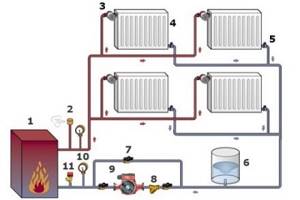
The installation of a heating system begins with the installation of a gas boiler according to all the rules, connecting it to the water pipes.
Radiators are installed under the window - they are hung on brackets that are embedded in the walls. The optimal distance from the floor and window sill is 10-12 cm. The gap between the wall of the house and the radiator should be at least 5 cm.
There are several options for connecting pipes to batteries:
- lower;
- one-sided;
- cross;
- single-pipe.
Optimal for heat transfer is a one-sided connection. Diagonal is used when the number of sections is more than 12, and heat loss in this case is minimal - about 2%. The lower connection is used when connecting the radiator to the floor screed, in which the heat-generating system is hidden, but heat loss increases up to 10%. The most unprofitable option is single-pipe.
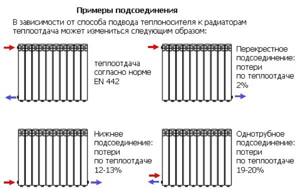
It is advisable to install a Mayevsky tap, a plug and foot nuts on each radiator. The tap should be located on the right side, the plug on the left. Shut-off and control valves should be installed into the lower pipelines.
Important! When installing, radiators should be centered. If they are installed at an angle, this will increase fuel consumption or lead to a complete lack of functionality. If the battery is tilted towards the Mayevsky tap, then it will not be possible to expel air from the system.
After installing all the radiators, they proceed to laying the pipeline. It can be made open or closed. The first method is classic and the simplest: pipes are laid along the walls above the floor and secured with clips. The disadvantage is the unaesthetic appearance of the pipe.
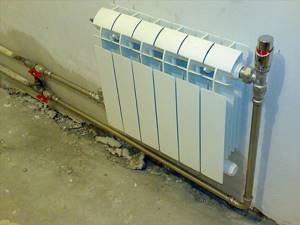
The second method is to install pipelines invisibly. If insulation is planned, they are hidden under drywall or other insulation. In another case, the device involves gating walls or floors. Pipes located under the insulation or in the wall must be additionally insulated with Merylon, which makes it possible to reduce heat loss and leave space for thermal expansion.
For autonomous heating devices, pipes with a diameter of ¾ inches are used, and for connecting batteries with a tee, pipes with a diameter of ½ inch are used.
Choosing a gas boiler for an apartment
First, choose a gas unit. By the time official consent is received for the installation of this device, it is already determined which gas boiler to choose for heating the apartment, since for approval it is necessary to provide technical documentation for the proposed device.

For placement in an apartment, a wall-mounted unit with a closed combustion chamber is usually chosen. Depending on the need for hot water, choose a single-circuit or double-circuit device. It is also important to correctly calculate the required power of the unit in accordance with the area of the apartment, the degree of wall insulation, and the availability of hot water heating.
If the owner wants to connect additional systems to the unit, for example, a “warm floor,” then it is better to purchase a condensation model. It is able to work very economically at a coolant temperature of 50-60°C and produce an efficiency of 97-99%.
Important! If the temperature of the coolant in the condensing unit heats up above 60°C, then it already operates with the efficiency of a convection boiler.
Selection of radiators and pipes
Gas heating wiring can include both metal and plastic pipes. If the owner is going to install the heating system with his own hands, then a plastic pipeline is an easier option. Only a professional can install metal pipes.
There are several schemes for organizing a heating system. The most common and most suitable for apartments are single-pipe and two-pipe schemes. The first option is more economical, but if the pipe is clogged, the entire system will become worse at heating the apartment. For two-pipe heating it will be necessary to spend more material, but if a problem occurs in one pipe, the coolant will be able to circulate through the second. With a single-pipe version, a diagonal connection is ideal, then the coolant will be in contact with the inner surface of the radiators.
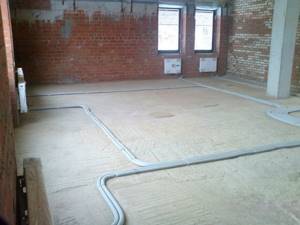
For one-room and two-room apartments of standard size, a single-pipe system is suitable, and for large living spaces, a two-pipe system is suitable.
When installing a heating system made of plastic, it is allowed to use only reinforced polypropylene pipes. Unlike conventional products, this material is not subject to corrosion and expansion from exposure to high temperatures. These types of pipes are reinforced with aluminum foil or fiberglass. Thanks to this, polypropylene products can withstand heating up to 70-90°C.
Important! Antifreeze or water acts as a coolant for gas heating.
When choosing a radiator, in stores you can find products made of cast iron, steel or bimetallic (a mixture of steel and aluminum). It is the latter that have the best performance, so consumers often opt for such batteries. In this case, it is important to correctly calculate how many elements will be needed to heat each room.
What to choose: single-pipe or two-pipe heating system
Two-pipe heating system
There are only two types of heating systems: single-pipe and double-pipe. In private homes, they try to install the most efficient heating system
It is very important not to go cheap when trying to reduce the cost of purchasing and installing a heating system. Providing heat to your home is a lot of work, and so as not to have to install the system again, it is better to understand it thoroughly and make “reasonable” savings.
And in order to draw a conclusion about which system is better, it is necessary to understand the operating principle of each of them. Having studied the advantages and disadvantages of both systems, both from the technical and material side, it becomes clear how to make the optimal choice.
Is it possible to do the installation yourself?
In order not to hire specialists, but to do the installation yourself, you need to know how individual heating works. But even after studying all the nuances, such actions as installing the boiler and auxiliary equipment, connecting gas and laying risers should be carried out by specialists from the relevant services. But everyone can install radiators. The main thing is to check the tightness before using the system. Leaks are usually detected at the junctions of radiator sections or pipes and radiators. A reliable way to check for leaks is to let coolant into the system. You must be prepared to immediately fix the leak so as not to flood your neighbors.
